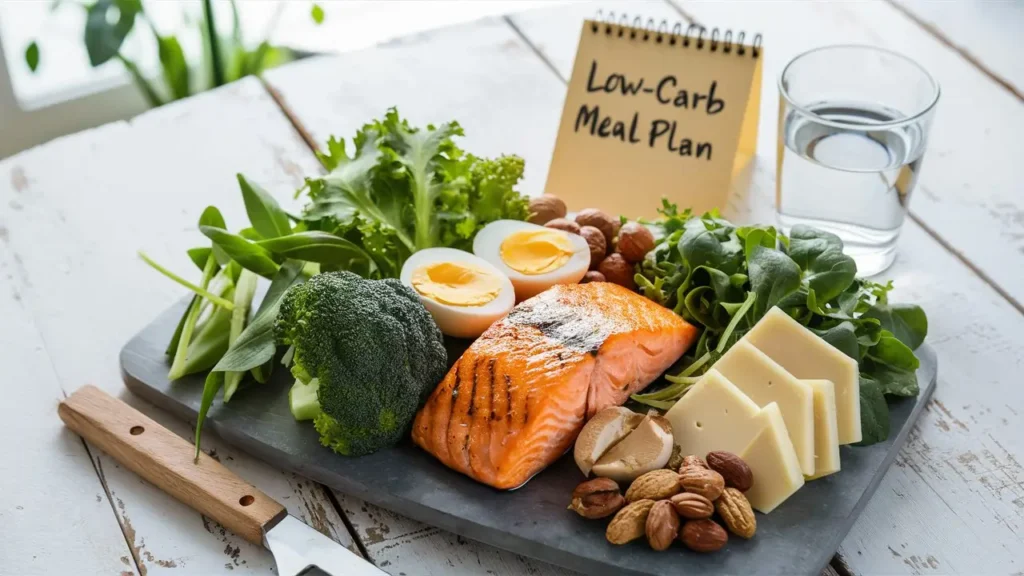When I first tried a low carb diet for weight loss, I was skeptical. Giving up pasta and bread seemed impossible. But after a few weeks, I noticed not only weight loss but also more energy and better health.
The low-carb diet for weight loss isn’t a trend. Research shows that cutting carbs can boost insulin sensitivity and aid fat loss. I get how overwhelming it can seem, but it’s about finding a balance that works for you.
In this article, I’ll share the benefits of a low-carb diet. I’ll support these benefits with science. I’ll also share practical tips to kickstart your weight loss journey and boost your health. Let’s dive in.
Exploring the Science of Low-Carb Diets and Their Effects
Starting a low-carb diet means understanding carbs and insulin. The Mayo Clinic says carbs are our main energy source. When we eat carbs, our bodies turn them into glucose for our cells.
Insulin is key in managing weight by controlling blood sugar. Low-carb foods and recipes can lower insulin, helping you lose weight. A low-carb diet limits carbs to 0.7 to 2 ounces (20 to 57 grams) daily.
Having many low-carb recipes makes switching to a low-carb diet easier. Try cauliflower rice, zucchini noodles, and lettuce wraps. These can help you eat fewer carbs and more healthy fats and proteins.
Benefits of Following a Low-Carb Diet for Weight Loss
Following a low-carb diet can lead to many benefits. You might lose weight and see better blood sugar and insulin levels. By eating fewer carbs, you lower your insulin, helping you lose weight. Also, low-carb diet tips help you make lasting lifestyle changes. This includes moving more and eating more protein and healthy fats.
Low-carb diets can lead to great results. You may feel less hungry, have more energy, and improve your health. Many people lose 2-3 times more weight on a low-carb diet than on a low-fat diet. Low-carb diets also lower bad fats, raise good cholesterol, and lower blood pressure. These changes can lower your risk of heart disease and stroke.
A low-carb diet offers many benefits:
-
It lowers blood sugar and insulin levels.
-
You can feel more energetic.
-
Mental focus improves.
-
There is less inflammation and a stronger immune system.
By sticking to a low-carb diet and using low-carb diet tips, you can lose a lot of weight and get healthier. Results may vary, but with the right plan, you can enjoy the many perks of a low-carb lifestyle.
Getting Started: Essential Steps for Low-Carb Success
Starting a low-carb diet is exciting. It’s key to know how many carbs you can eat each day. Diets like the ketogenic or Atkins diet aim for less than 26% of calories from carbs. This means you must plan your meals to stay within your carb limit.
Foods with around 15 grams of carbs are:
-
Two slices of low-calorie bread.
-
1/4 of a large bagel.
-
One small apple.
A low-carb diet can also help manage insulin levels. This makes it good for losing weight and managing type 2 diabetes.
Here are some tips for healthy eating on a low-carb diet:
-
Eat whole, unprocessed foods like vegetables, meat, and healthy fats.
-
Stay away from sugary drinks and snacks that are high in carbs.
-
Make sure to include physical activity in your daily routine to help with weight loss.
Remember, everyone’s nutritional needs are different. Always talk to a healthcare professional before starting a new diet. With the right plan and a bit of effort, you can succeed on a low-carb diet. Enjoy the benefits of healthy eating for weight loss.
Foods to Embrace and Avoid on Your Low-Carb Journey
Following a low-carb diet for weight loss means knowing which foods to eat and avoid. A good low-carb diet includes whole foods like meats, veggies, and healthy fats. But it limits foods high in carbs, such as grains, starchy veggies, and sugary snacks.
To succeed on your low-carb diet, focus on these food groups:
-
Green light foods: non-starchy veggies like spinach, broccoli, and cauliflower. They’re low in carbs and full of nutrients.
-
Yellow light foods: foods with moderate carbs, like nuts, seeds, and avocados. Eat them in moderation.
-
Red light foods: high-carb items like sugary drinks, grains, and starchy veggies. Try to avoid them.
By knowing these food groups and adding them to your meal plan, you’re on the right path. Always choose whole, nutrient-rich foods. Limit processed and high-carb foods to reach your weight loss goals.
Crafting Your Perfect Low-Carb Meal Plan

Exploring low-carb foods and low-carb recipes can be a lot to take in. To begin a low-carb diet, finding a balance that suits you is crucial. A common approach is to alternate between high- and low-carb days six times a week, with a special meal day.
For weight loss, try a schedule of five low-carb days and two high-carb days. This can help you manage your carb intake effectively.
To start a low-carb diet, focus on whole, unprocessed foods. These foods are better for your nutrition. It’s also important to control your portions and eat mindfully. This helps you stay aware of how many carbs you’re consuming.
Here’s a sample meal plan to consider:
-
Day 1: 1,200 calories, with 77 g of fat, 21 g of carbs, and 85 g of protein.
-
Day 2: 1,100 calories, with 68g of fat, 33g of carbs, and 75g of protein.
Don’t forget to drink plenty of water and listen to your body. You can meet your weight goals and improve your health with low-carb foods and recipes.
Common Challenges and How to Overcome Them
Following a low-carb diet can be tough. You might face strong carb cravings. Staying hydrated and getting enough sleep can help fight these cravings. This makes it easier to stay on track with your diet.
Dealing with social situations where carbs are everywhere is another hurdle. To tackle this, have a plan ready. Eat before going out, or bring your low-carb food. These low-carb diet tips let you enjoy benefits like weight loss and better health.
Some people may experience the “low-carb flu.” Symptoms include tiredness, headaches, and nausea. To avoid this, stay hydrated and listen to your body. If you’re feeling these symptoms, talk to a doctor. Understanding the diet’s benefits and using these tips can help you lose weight. You’ll also see the positive effects of a low-carb lifestyle.
-
Stay hydrated by drinking at least 2 quarts of water per day.
-
Get enough sleep to help reduce cravings and improve health.
-
Eat before events or bring low-carb food to handle social situations.
Exercise and Low-Carb Living: Finding the Right Balance
Following a low-carb diet for weight loss means finding the right mix of diet and exercise. Regular workouts are key for health and losing weight. A low-carb meal plan can support your workout routine.
The best low-carb diet has less than 26% of daily calories from carbs. For a 2000-calorie diet, that’s less than 130 grams of carbs daily. Combining a low-carb diet for weight loss with exercise can put you in a ketogenic state. This state is great for losing weight.
Here are some simple ways to maintain a balance between diet and exercise:
-
Avoid sweet snacks, refined grains, and processed foods.
-
Eat high-fat foods from natural sources like meat, fish, nuts, avocados, olive oil, and dairy.
-
Check ketone levels to see if you’re burning fat.
Success with a low-carb meal plan depends on finding a balance that fits your life. Mix a great low-carb diet with exercise and a healthy lifestyle. Doing this helps you lose weight and improve your health.
Tracking Your Progress and Adjusting Your Approach
As you keep going on your weight loss journey, it’s key to track your progress and tweak your plan as needed. This is true for diets like the ketogenic diet and the Atkins diet. By watching your progress, you can see what’s working and what’s not. This helps you make smart choices for your healthy eating and weight loss plan.
Using tools like a food diary or a mobile app is crucial. They help you keep track of what you eat and how much you move. This way, you can spot patterns and tweak your diet and exercise. You might notice you’re eating too many carbs or not enough protein. This can slow down your weight loss.
When it’s time to adjust your approach, consider your entire healthy eating plan for weight loss. Adjust your carb limit, change your macronutrient balance, or try new foods. By making smart choices and sticking to your plan, you can beat common hurdles. You can achieve your weight loss goals, whether you’re on a ketogenic diet, Atkins, or any low-carb diet.
Conclusion: Your Path to Low-Carb Success
A low-carb diet can help you lose weight and get healthier. Studies show it works well for weight loss and improving health markers like blood sugar and cholesterol.
Every person’s journey is different. So, be patient and try different ways to find what works for you. With the right mindset and support, a low-carb diet can become a lasting change.
Start your low-carb journey today for a healthier life. Talk to a doctor to make sure it’s right for you. And don’t be afraid to ask for help. Good luck on your path to low-carb success.
FAQ
What is a low-carb diet, and how does it work for weight loss?
A low-carb diet cuts down on carbs, which are our main energy source. This leads to the body burning fat instead. This state is called ketosis, and it helps with weight loss.
What are the advantages of eating a low-carb diet?
Reducing carbs in your diet can help you lose weight. It also reduces hunger, improves blood sugar and insulin levels, and boosts energy.
How do I get started on a low-carb diet?
To start a low-carb diet, first figure out your daily carb limit. Then, clean your kitchen and buy low-carb foods and ingredients.
What foods should I eat and avoid on a low-carb diet?
On a low-carb diet, eat green light foods like leafy greens, healthy fats, and lean proteins. Avoid yellow light foods like whole grains and fruits. Also, stay away from red light foods like sugary and processed carbs.
How do I create a balanced, low-carb meal plan?
To make a balanced low-carb meal plan, mix low-carb foods and recipes you like. Stay within your daily carb limit. Try different dishes and find what works best for you.
How do I overcome common challenges on a low-carb diet?
Common challenges include carb cravings, managing social situations, and the “low-carb flu.” With the right strategies and support, you can beat these challenges and stay on track.
How important is exercise on a low-carb diet?
Exercise is key to a healthy lifestyle, and it’s even more important with a low-carb diet. It helps with weight loss and health. Finding the right balance between exercise and low-carb living is crucial.
How do I track my progress and adjust my low-carb approach?
Tracking your progress and using monitoring tools are vital. Being willing to make changes is key to long-term success on a low-carb diet.
